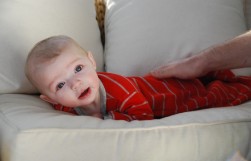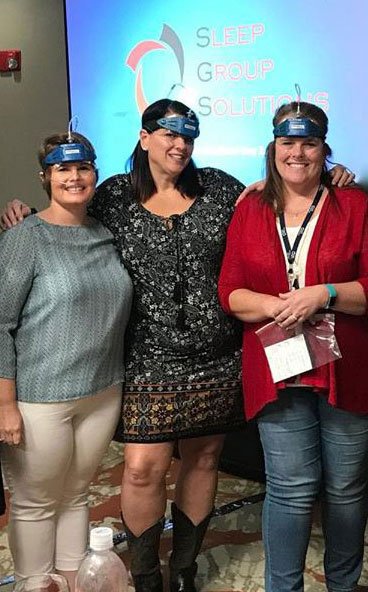WHY DO SOME SEEM TO BE AWAKENED EASILY?
Some of us are known to be “sound sleepers” That is, we can sleep while our neighbor is blasting his highly amplified distortion of Heavy Metal non-music, or during a 5.0 earthquake or even the freight train roar of a partner’s snoring. Others of us are “light sleepers” and may be awakened by the family cat gliding from the sofa to the floor. These differences exist for children as well as for adults. Why the difference between these two sleeping modes?
First. let’s take a little look at the science of sleep.
When a human falls asleep, the body and mind experience progressive levels of sleep. A 5 stage sleep cycle repeats consistently throughout the night. One complete sleep cycle lasts about 90 minutes. So during an average night’s sleep (8 hours), an adult will experience about four or five cycles of sleep.
There are 4 stages of Non-REM (Non Rapid Eye Movement) and a final stage of REM sleep (Rapid Eye Movement)
There are 4 stages of Non-REM (Non Rapid Eye Movement) and a final stage of REM sleep (Rapid Eye Movement)
SLEEP STAGES
- The beginning stages of sleep prepare your body to shut down. This includes dozing off and the ability to be easily awakened by noise or thoughts.
- Deep sleep occurs in the later stages – when activity in the body is low and activity in the brain is very high.
- Stage 1 The Gateway to Sleep. It’s associated with a low arousal threshold and is the shortest duration of sleep- approximately 5%
- Stage 2 The conscious awareness of the external environment is gone. This is approximately 45% (10-15 minutes)
- Stages 3 and 4: Deep Sleep (or Delta Sleep) are the most refreshing of the sleep stages. They’re also the sleep stages during which the body releases hormones that contribute to growth and development. Brain activity is slowed, heart rate, respiration and blood pressure are lowered and it is very difficult to wake someone from this Delta sleep stage. This stage is 25%.
- Incrementally larger stimuli are needed for arousal as sleep progresses thru the 4 stages.
REM SLEEP
- REM sleep is the last stage of the sleep cycle, 20-25%, and is the stage of sleep where we have our most vivid dreams. The dreams we remember- at least for a few minutes after we wake.
- REM is not deep sleep like some think.
- During REM sleep, other physical changes take place — breathing is rapid, the heart beats faster, and the skeletal muscles are paralyzed.- maybe that is nature’s way of protecting us from acting out our dreams.
- REM sleep episodes lengthen across the night. As the stage 3 and 4 Short Wave Sleep (SWS) segments diminish in length, the REM segments increase.
Being awoken in the middle of REM sleep can cause grogginess that has the potential to last throughout the morning and even throughout the day. This explains why sometimes we sleep for eight or nine hours and still feel like we barely got any rest at all. Waking up in the beginning stages of a sleep cycle is healthy because our bodies are not yet entirely shut down.
SLEEP NEEDS BY AGE
There’s no one-size-fits-all answer regarding how much daytime sleep people need. It all depends on the age and the sleep total during a 24-hour period. For example, a toddler may sleep 13 hours at night with only some daytime catnapping, while another gets 9 hours at night but takes a solid 2-hour nap each afternoon.
Though sleep needs are highly individual, these age-by-age guidelines give an idea of average daily sleep requirements:
Birth to 6 months: Infants require about 16 to 20 total hours of sleep per day. Younger infants tend to sleep on and off around the clock, waking every 2 or 3 hours to eat. As they approach 4 months of age, sleep rhythms become more established. Most babies sleep 10 to 12 hours at night, usually with an interruption for feeding, and average 3 to 5 hours of sleep during the day (usually grouped into two or three naps).
6 to 12 months: Babies this age usually sleep about 11 hours at night, plus two daytime naps totaling 3 to 4 hours. At this age, most infants do not need to wake at night to feed, but may begin to experience separation anxiety, which can contribute to sleep disturbances.
Toddlers (1 to 3 years): Toddlers generally require 10 to 13 hours of sleep, including an afternoon nap of 1 to 3 hours. Young toddlers might still be taking two naps, but naps should not occur too close to bedtime, as they may make it harder for toddlers to fall asleep at night.
Preschoolers (3 to 5 years): Preschoolers average about 10 to 12 hours at night, plus an afternoon nap. Most give up this nap by 5 years of age.
School-age (5 to 12 years): School-age kids need about 10 to 12 hours at night. Some 5-year-olds might still need a nap, and if a regular nap isn’t possible, they might need an earlier bedtime.
TEENS’ SLEEP
Research shows that teens need 8½ to 9½ hours of sleep a night. So, a teen who needs to wake up for school at 6 a.m. would have to go to bed at 9 p.m. to reach the 9-hour mark. Studies have found that many teens have trouble falling asleep that early, though. It’s not because they don’t want to sleep. It’s because their brains naturally work on later schedules and aren’t ready for bed.
During adolescence, the body’s circadian rhythm (an internal biological clock) is reset, telling a teen to fall asleep later at night and wake up later in the morning. This change in the circadian rhythm seems to be due to the fact that the brain hormone melatonin is produced later at night in teens than it is for kids and adults. So, teenagers have a harder time falling asleep.
Sometimes this delay in the sleep-wake cycle is so severe that it affects a teen’s daily activities. In those cases it’s called delayed sleep phase syndrome, also known as “night owl” syndrome. And if your sleep-deprived teen brings mobile devices into bed, surfing or texting late into the night, the light exposure could also disrupt circadian rhythm and make it harder to sleep.
CONCLUSION
Maybe the “light sleepers” just need to be given a chance to descend into the deep sleep stages before you practice your trumpet lessons.
SOURCES
1. Sleep. (23 Oct. 2007).WordNet 3.0. Princeton University.
2. National Sleep Foundation. (2002). Sleep in America Poll.
3. Dement, W. C. (1999).e Promise of Sleep
4.National Highway Traffi c Safety Administration. National Survey of Distracted and Drowsy Driving Attitudes and Behavior: 2002.
5.Long, T. (2008). Dec. 3, 1984: Bhopal, ‘Worst Industrial Accident in History’.Wired.
Accessed at http://www.wired.com/science/discoveries/news/2008/12/dayintech_1203 .
6.United States Nuclear Regulatory Commission. (2013).
Backgrounder on Chernobyl Nuclear Power Plant Accident.Accessed at http://www.nrc.gov/reading-rm/doc-collections/fact-sheets/chernobyl-bg.html .
7. National Geographic New, 24 Feb. 2005.
8. Personal account with the author.
9. Dement, W. C. (1999).e Promise of Sleep
10.Circadian Rhythm. (29 Oct. 2007).American Heritage ScienceDictionary. Houghton-Miffl in.
11.Butkov. (2007).Fundamentals of Sleep Technology.
12.Sleep Management Services. (2002)Principles of Polysomnography.
13.Principles and Practice of Sleep Medicine, 3rd ed.
14.Sleep Management Services. (2002).Principles of Polysomnography.
15.Butkov. (2007).Fundamentals of Sleep Technology.
16. Suzuki, K., et al., (2003). Sleep. 26(6).
17. National Sleep Foundation. (2007). Sleep in America Poll





